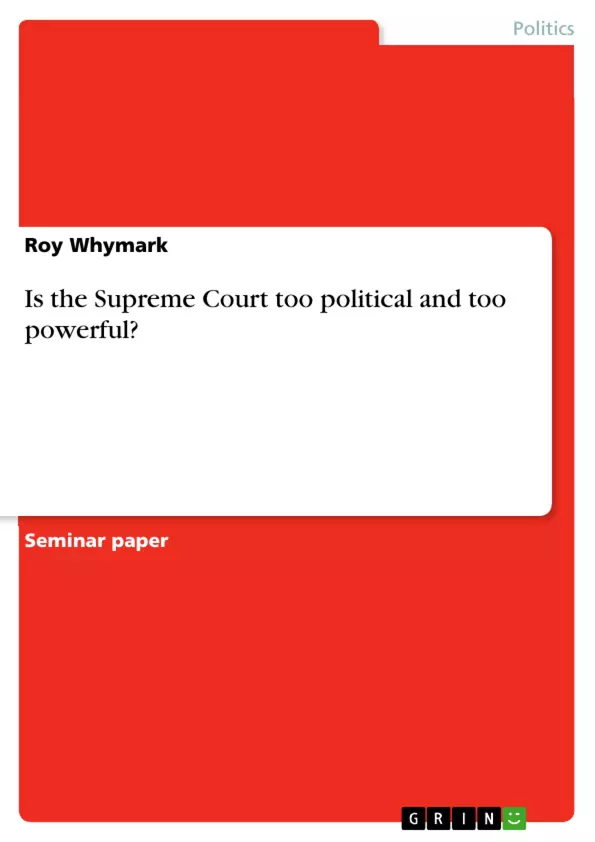The US Supreme Court bears the incredible responsibility for deciding the constitutional
validity of cases by judging the merits of each against the Constitution. Given the context in
which the Constitution was written and its often ambiguous language, the task facing the nine
Justices is not simple and the Court’s activities not without controversy. The influence of the
Court has generated swathes of literature concerning how the Constitution is applied and how
effective those applications have been in shaping public policy.
There can be little doubt that the Supreme Court is both powerful and political and has had a
major impact on American society. Indeed, it was the Court that ruled racial segregation in
schools to be unconstitutional (Brown v. Board of Education 1954); guaranteed the rights to
counsel and due process (Gideon v. Wainwright 1963); established the constitutional right of
abortion (Roe v. Wade 1973); and famously, or perhaps infamously, halted the Florida recount,
effectively awarding the presidency to George W. Bush (Bush v. Gore 2000).
This essay takes the notion that the Court is both political and powerful as given but explores
whether it is too political and too powerful, to the degree that its decisions have a detrimental
impact on the functioning of US democracy.
In considering this issue, one needs to consider outcomes (how the Court has actually shaped
public policy). This essay will focus on three policy areas where the Court has made
landmark decisions (abortion, civil rights, and gun control) and explains that while the Court
is, by its nature, highly political and also powerful, it does not operate in a vacuum and its
influence on society in constrained by the separation of powers, the federal nature of politics,
and public opinion.
Supreme Court functions
Before turning to the Supreme Court’s influence on public policy, it is worth understanding
what the Court is intended for. Article III of the Constitution states that ‘the judicial power of
the United States shall be vested in one supreme court’. This role manifests itself in two
judicial review functions: (i) statutory interpretation; and (ii) constitutional interpretation of
legislation. [...]
Inhaltsverzeichnis (Table of Contents)
- Supreme Court Functions
- Statutory Interpretation
- Constitutional Interpretation
- Abortion
- Civil Rights
- Gun Rights
Zielsetzung und Themenschwerpunkte (Objectives and Key Themes)
This essay aims to examine whether the US Supreme Court is too political and too powerful, exploring its impact on the functioning of American democracy. While acknowledging the Court's inherent political nature and influence, the essay analyzes its decisions in three key policy areas: abortion, civil rights, and gun control.
- The balance of power in the US political system
- The role of the Supreme Court in interpreting the Constitution and shaping public policy
- The influence of public opinion and interest groups on the Court's decisions
- The effectiveness of the Court's rulings in achieving social change
- The tension between individual rights and the collective good
Zusammenfassung der Kapitel (Chapter Summaries)
The essay begins by exploring the Supreme Court's two key functions: statutory interpretation and constitutional interpretation. The author argues that while the Court's role in statutory interpretation is less controversial, its constitutional interpretation function is inherently political. The essay then examines the Court's influence on public policy in three key areas: abortion, civil rights, and gun rights.
In the section on abortion, the author discusses landmark cases such as *Roe v. Wade* and *Planned Parenthood v. Casey*, demonstrating how the Court's decisions have shaped the legal landscape around abortion access. The section explores the impact of public opinion, legislative action, and the role of interest groups in influencing outcomes related to abortion rights.
The section on civil rights examines the Supreme Court's pivotal role in the desegregation of schools, starting with *Plessy v. Ferguson* and culminating in *Brown v. Board of Education*. The author discusses the Court's limited ability to enforce its rulings and the subsequent reliance on legislative action, such as the Civil Rights Act of 1964, to achieve social change. The essay also highlights the persistence of racial segregation in schools, despite the Court's rulings.
The final section on gun rights focuses on the Court's recent decisions concerning the Second Amendment, specifically *DC v. Heller*. The author argues that the Court's interpretation of the Second Amendment reflects an attitudinal approach and highlights the ongoing debate around the balance between individual rights and public safety.
Schlüsselwörter (Keywords)
This essay explores key themes such as the US Supreme Court, constitutional interpretation, public policy, judicial review, abortion rights, civil rights, gun control, separation of powers, federalism, public opinion, and interest groups. The essay also examines the influence of landmark Supreme Court decisions, such as *Roe v. Wade*, *Brown v. Board of Education*, and *DC v. Heller*, on American society. The analysis considers the balance of power between the judicial branch and the legislative and executive branches, as well as the impact of public opinion and political pressure on the Court's decisions.
- Quote paper
- Roy Whymark (Author), 2012, Is the Supreme Court too political and too powerful?, Munich, GRIN Verlag, https://www.grin.com/document/207475



